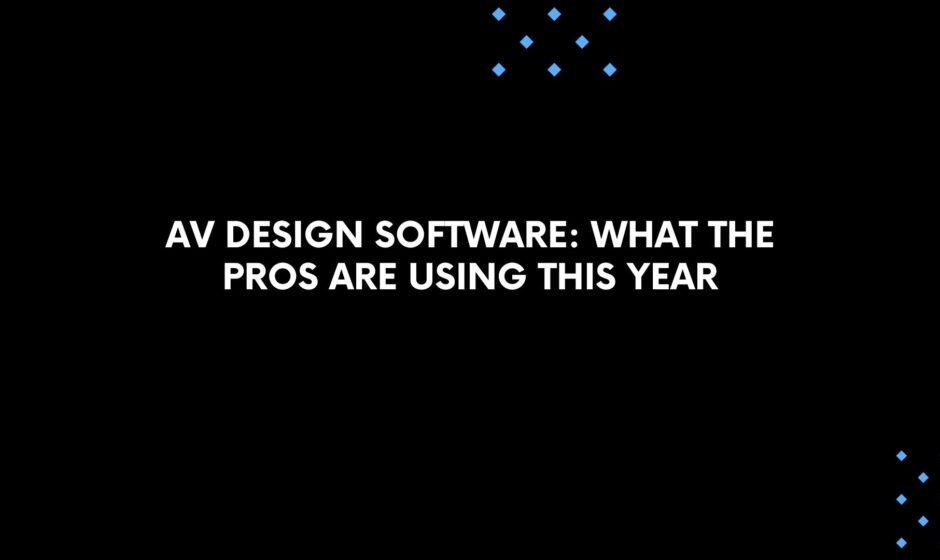Designing audio visual systems has become more complex as technology advances and client expectations rise. From conference rooms and auditoriums to classrooms and digital signage networks, today’s AV projects demand precision, scalability, and seamless integration with modern technology. To meet these challenges, AV professionals rely on specialized software tools to plan, design, document, and manage their projects. Two of the leading solutions in this space are XTEN-AV and D-Tools. Both platforms aim to make the design and documentation process faster, more accurate, and easier to manage. But how do they compare? And which AV Design Software is the right choice for your business? In this blog, we will break down the strengths of each platform and help you decide.
Why AV Design Software Matters
Before we dive into the comparison, let’s take a quick look at why AV design software is essential for modern integrators and consultants.
A professional AV design tool allows you to:
-
Create detailed system schematics and signal flow diagrams.
-
Build bills of materials (BOMs) and equipment lists automatically.
-
Generate proposals, quotes, and documentation faster.
-
Collaborate with teams and clients efficiently.
-
Reduce errors and rework by standardizing designs and processes.
In short, the right AV design software can save time, improve accuracy, and enhance the overall client experience.
XTEN-AV: The Modern Cloud-Based Solution
XTEN-AV is a relatively newer player in the AV design space but has quickly gained attention for its cloud-first approach and automation features. Designed specifically for the AV industry, XTEN-AV offers a fresh take on how AV professionals can work smarter.
Key features of XTEN-AV:
-
Cloud-based platform — Access your projects from anywhere, collaborate with your team in real time, and avoid version control issues.
-
AI-powered design — XTEN-AV offers automation tools that help you generate signal flow diagrams, rack layouts, and BOMs in minutes.
-
Extensive library — The software includes a large library of AV products, with manufacturer data built in for accurate designs and proposals.
-
Integrated proposal builder — Create professional proposals with branding, pricing, and technical documents all in one platform.
-
Collaboration tools — Share projects easily with clients, partners, and team members through cloud links.
XTEN-AV focuses on streamlining the entire AV project workflow, from design to documentation to proposal generation.
D-Tools: A Trusted Industry Veteran
D-Tools has been a staple in the AV industry for more than two decades. Known for its powerful design and project management capabilities, D-Tools is widely used by integrators who need robust tools for both residential and commercial projects.
Key features of D-Tools:
-
Comprehensive design tools — D-Tools offers advanced features for creating detailed schematics, floor plans, and system drawings.
-
Project management integration — The platform connects design work to scheduling, purchasing, and installation management.
-
Large product database — Access an extensive catalog of AV and low-voltage products with detailed specifications.
-
On-premise and cloud options — Choose between the traditional on-premise SI (System Integrator) version or the newer D-Tools Cloud.
-
Powerful reporting — Generate a wide range of reports, including proposals, purchase orders, and installation guides.
D-Tools appeals to firms that want a mature, full-featured solution for handling both the technical and business sides of AV integration.
Comparing XTEN-AV and D-Tools
Now let’s look at how XTEN-AV and D-Tools stack up in several key areas.
1. Cloud Access and Collaboration
XTEN-AV is built entirely in the cloud. This means there is no software to install, and your team can access projects from any device with an internet connection. It also allows for real-time collaboration, with multiple users able to work on a project simultaneously.
D-Tools offers cloud options (D-Tools Cloud) but still has many users on the on-premise SI platform. While D-Tools Cloud provides collaboration features, it is not as deeply integrated into the entire platform as XTEN-AV’s cloud-native approach.
2. Automation and AI
XTEN-AV sets itself apart with its AI-driven features. It can automate the creation of signal flow diagrams, rack layouts, and BOMs based on your input, which can significantly speed up the design process.
D-Tools offers automation primarily through templates, macros, and preconfigured packages. While powerful, these features require more manual setup compared to XTEN-AV’s AI assistance.
3. Design Capabilities
Both platforms provide tools to create professional AV designs.
-
XTEN-AV shines when you want speed and automation to generate clean, easy-to-understand diagrams.
-
D-Tools offers more advanced drawing tools, especially if you need highly detailed schematics, plan views, or integration with CAD platforms.
If your projects require complex architectural or engineering drawings, D-Tools may offer more depth in this area.
4. Proposal and Documentation Tools
XTEN-AV includes a built-in proposal generator that helps you create branded documents quickly. It links design work directly to proposals, making it easy to update pricing or specs as the design evolves.
D-Tools is well known for its powerful reporting and proposal tools. You can customize reports in detail and generate everything from simple quotes to detailed installation guides.
5. Learning Curve and Ease of Use
XTEN-AV focuses on user-friendly design. The interface is clean and modern, and many users report that it is easy to learn, even for those new to AV design software.
D-Tools, with its wide range of features, can have a steeper learning curve. However, once mastered, it offers immense power and flexibility.
6. Pricing and Deployment
XTEN-AV offers subscription pricing with cloud access included. This can be more cost-effective for small to mid-sized firms that want to avoid large upfront costs.
D-Tools offers both subscription and perpetual license models, with pricing that reflects its position as an enterprise-grade solution.
Which AV Design Software Is Right for You?
If you are looking for a modern, cloud-based platform with automation features that speed up design and documentation, XTEN-AV is an excellent choice. It is ideal for firms that value flexibility, collaboration, and efficiency.
If you need a deeply featured platform with advanced drawing tools, project management integration, and mature reporting, D-Tools may be the better fit. It is well suited for firms managing large, complex projects with extensive documentation needs.
Read more: https://audiovisual.hashnode.dev/top-av-design-software-tools-for-2025
Conclusion
Both XTEN-AV and D-Tools are powerful AV Design Software solutions that can elevate your projects. The best choice depends on your specific needs, workflow, and business goals. Consider what features matter most to your team and how you plan to grow in the future.
If you would like a personalized comparison or a demo of either platform, let me know. I can help you evaluate the right solution for your next project.
How AI-Powered Signal Flow Diagram Software is Changing AV Design




How Churches Can Streamline Installations with AV Design Software - Kinked Press 3 Jul 2025
[…] Read more: https://fastpanda.in/2025/07/03/xten-av-vs-d-tools-which-av-design-software-is-right-for-you/ […]